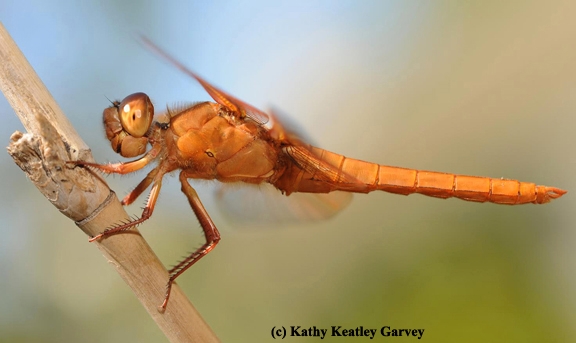- Author: Kathy Keatley Garvey
It's a buggy new year! One of the fascinating things about beginning the new year is the Entomological Society of America's "World of Insects" calendar. Amazing images of insects (and one spider!) jump out at you.
One of my favorites is a black soldier fly, Hermetia illucens, an image captured by entomologist Jena Johnson of Athens, Ga. It's "Mr. October."
Johnson writes: "Soldier flies, like many other dipterans, have beautifully patterned eyes attributable to cornea filters that cause colorful metallic reflections. Adults of this species are black with dark wings and are 14-17 millimeters long. Although harmless, they are somewhat similar in appearance to mud dauber wasps, and they even mimic their movements. They also have two distinctive translucent spots on their first abdominal segments that make them appear to have narrow, wasplike waists. The larvae develop in decomposing organic matter and are considered to be beneficial in helping to reduce large amounts of animal manure and other biological wastes. Soldier fly larvae are a good protein food source for livestock, exotic pets and even humans. In the summer, adults are often attracted to fluorescent lights, which is how this one was lured in for a photograph in Athens, Georgia."
"The first time I looked into the eyepieces of a microscope to see the magnified beauty of an insect I knew I would spend my life involved somehow in learning more about this diverse and fascinating group of animals," Johnson told Bug Squad. "After working at the University of Florida for a couple of years I went on to earn a master's degree at Clemson University. I worked as an entomology laboratory technician at the University of Wisconsin and am currently at the University of Georgia. For many years I photographed insects with a 35mm film camera but when digital cameras became more affordable a few years ago, my passion for insect photography was reignited. I photograph insects for the pure joy it brings me. I live in Athens, Georgia with my husband Michael Strand, who is also an entomologist."
Michael Strand, by the way, will be the featured speaker April 8 in the series of noonhour seminars hosted by the UC Davis Department of Entomology and Nematology. (See list of seminar speakers.)
Jena Johnson, who is currently hotographing a variety of mosquito species emerging from pupae at the water's surface, is an alumnus of BugShot, an insect photography workshop. One of the instructors is noted insect photographer Alex Wild, who received his doctorate in entomology at the University of California, Davis, with professor/ant specialist Phil Ward. Wild, who has just accepted a position at the University of Texas, Austin, blogs about insects at myrmecos.net and about photography at Compound Eye, Scientific American. Wild's Oct. 26 2011 seminar at UC Davis on "How to Take Better Insect Photographs" is the department's most viewed seminar on UCTV.
It's obvious that people like bugs, and people enjoy capturing macro images of bugs!
A colorful image of a clown grasshopper by Francisco Lopez-Machada of Cali, Colombia, graces the cover of ESA's "World of Insects" calendar. It also appears as "Mr. August."
The list of images and the photographers:
January: Spitting spider, Scytodes thoracica, by Daniel D. Dye II of Brooker, Fla.
February: Speckled-winged grasshopper, Arphia conspersa, by Johan Pretorius of Scottsbluff, Neb.
March: Imperial moth, Eacles ormondei peruviana, by Christopher Conland of Escondido, Calif.
April: Red dwarf honey bees, Apis florea, by Darren McNabb of Iowa City, Iowa
May: Stink bug, Edessa sp., by Francisco Lopez-Machado of Cali, Columbia
June: White-lined sphinx moth, Hyles lineata, by Keith Kennedy of Raleigh, N.C.
July: Dog-day cicada, Tibicen canicularis, by Keith Kennedy of Raleigh, N.C.
August: Clown grasshopper, Paramastax rosenberg, by Francisco Lopez-Machado of Cali, Colombia
September: Rove beetle, Philonthus caeruleipennis, by Tom Myers, Lexington, Ky.
October: Black soldier fly, Hermetia illucens, by Jena Johnson of Athens, Ga.
November: Luna moth, Actias luna by Tom Myers, Lexington, Ky.
December: Flameskimmer dragonfly, Libellula saturata, by Kathy Keatley Garvey of UC Davis
The 7000-member ESA recently held its annual meeting in Portland, Ore., with president Frank Zalom, distinguished professor of entomology and an integrated pest management specialist at UC Davis, presiding.



- Author: Kathy Keatley Garvey
If you're into composting, chances are you've seen this one.
Common name: black soldier fly (BSF). Scientific name: Hermetia illucens.
Before you say "yecch"--wait! This is considered a beneficial insect because its larvae are quite desirable in compost piles. In fact, your friendly neighborhood compost instructor will probably teach you how to set up BSF bins.
The adult, about three-fourths of an inch long, looks like a dark wasp. A distinguishing feature: white tips on its tarsi (legs).
However, it's not the adult that's on the B (beneficial) list. It's the larval or immature form.
Cindy Wise, compost specialist volunteer coordinator with the Lane County office of the Oregon State University Extension Service, has a thing or two to say about the larvae of these black soldier flies.
“Soldier fly larvae are voracious consumers of nitrogen-dominant decaying materials, such as kitchen food scraps and manures," she says. "They almost exclusively populate compost bins or sheet-mulch compost piles and manure piles."
Good reason to have them around.



